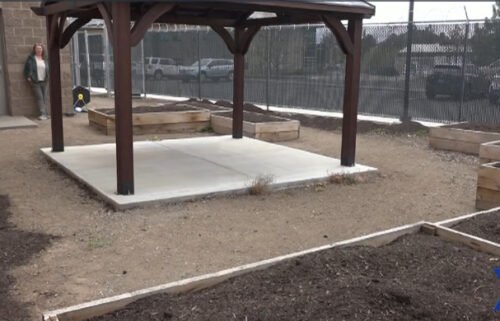$18.2 million in federal funds coming to Central Oregon projects to reduce forest fuels, threat of major wildfires
(Update: adding video, comments from U.S. Forest Service)
BEND, Ore. (KTVZ) -- Central Oregon national forests will be spending another $18.2 million this year on prescribed burns and other efforts to restore forest health, reduce wildfire fuels and reduce the threat of extreme blazes that threaten property, homes and lives.
Agriculture Secretary Tom Vilsack announced last week that the Biden-Harris Administration is investing nearly $500 million from President Biden’s Investing in America agenda to expand work on the USDA Forest Service’s Wildfire Crisis Strategy to reduce risk to communities, critical infrastructure and natural resources from the nation’s ongoing wildfire crisis, which is exacerbated by climate change.
These funds bring the total investment in this comprehensive strategy to an historic $2.4 billion, thanks to President Biden’s Inflation Reduction Act and Bipartisan Infrastructure Law. Vilsack said the funding also advances the Administration’s National Climate Resilience Framework to help expand and accelerate nationally comprehensive, locally tailored, and community-driven resilience strategies.
The Central Oregon Focal Landscape, as the region's efforts are called, will receive $18.2 million for the 2024 fiscal year, Deschutes National Forest Public Affairs Officer Kaitlyn Webb told NewsChannel 21.
"The wildfire crisis strategy at its heart is really about addressing this backlog of too much fuel on the ground that would lead to catastrophic wildfires that would endanger homes -- honestly, quite frankly, endanger lives." Kassidy Kern, public affairs officer for the Ochoco National Forest and Crooked River National Grassland, said Monday.
Much of the funding will go toward prescribed burns, which are fires intentionally set to reduce forest fuels that can feed and create more extreme wildfires.
Locals have been expressing concerns about the smoke from prescribed burns impacting air quality. The Forest Service acknowledges the concerns, but says it's by far the safer option.
Kern said, "I can tell you unequivocally, is I would 10 times rather have the shorter-duration prescribed fire smoke that's actually not toxic -- or if it is toxic and toxic at like 2 or 3 in the morning, vs. the things that we've had with these larger-scale wildfire events, where we're getting smoke consistently at unhealthy levels, even hazardous levels for days and even weeks at a time."
In addition to prescribed burns, the Deschutes National Forest will use the funding for commercial thinning and brush mowing.
The Crooked River National Grassland is also benefitting from the funds. The money will be used to remove juniper trees in the area and treat invasive weeds which can carry flames into homes.
"Juniper are not supposed to be all the places that they are here in Central Oregon. They create a massive fire disturbance, and they take a lot of water," added Kern.
Another $15.47 million will be allocated to the Klamath River Basin, and $4.97 million will go to the Mt. Hood Forest Health and Fire-Resistant Communities.
"The reason that we do that is we're trying to mimic what nature would have done for thousands of years if, you know, we had not come in as Euro-Americans and changed the way that things are here in our communities." explained Kern.
The Central Oregon Focal Landscape spans 2.6 million acres of state, county, private and federally managed lands on the eastside of the Central Cascades, including the Deschutes National Forest and the Crooked River National Grassland. Here's a two-page issue summary of the plans:
The rest of the Interior Department news release, in full:
“As climate change exacerbates the challenges our communities, forests and infrastructure face from catastrophic wildfires, our answer to those challenges have to match the scale of the threat,” said Secretary Vilsack. “We have already made progress, but there is still much to be done. This additional investment, thanks to President Biden’s investing in America agenda, will help deliver the tools and resources our employees, partners and communities need to protect lives and livelihoods across a vast, shared landscape.”
Approximately $400 million of the Inflation Reduction Act and Bipartisan Infrastructure Law funds will be allocated to ongoing efforts on the 21 designated priority landscapes identified in the strategy, making the total investment to date $1.6 billion. An additional $100 million will be allocated under a new program established by the Forest Service - the Collaborative Wildfire Risk Reduction Program - to expand work outside these landscapes. Inspired by past example and success of programs such as the Collaborative Forest Landscape Restoration Program, the new program expands work in high-risk wildfire areas outside the 21 priority landscapes.
The Collaborative Wildfire Risk Reduction Program will use hazardous fuels funds from the Inflation Reduction Act to treat areas outside the 21 priority landscapes in high-risk wildfire areas where national forests and grasslands meet homes and communities, known as the Wildland-Urban Interface. The program allows national forests, in collaboration with Tribes, communities and partners in 24 qualifying states to build local capacity for projects to reduce wildfire risk and improve forest health to protect communities, infrastructure, water quality and adjacent landowners.
A list of the qualifying states and criteria for eligible areas and projects can be found on the program webpage.
This announcement is part of President Biden’s Investing in America agenda to increase the resilience of lands facing the threat of catastrophic wildland fires and to better support federal wildland firefighters. The Bipartisan Infrastructure Law included $1.4 billion for the USDA Forest Service in wildfire risk reduction funds. The Inflation Reduction Act provided an additional $1.8 billion to reduce the risk of wildfire to neighborhoods, infrastructure, watersheds, and the many other benefits forests provide. All these investments will help strengthen long-term fire preparedness, reduce catastrophic wildland fire risk across states, and invest in supporting the wildland firefighter workforce.
In January 2022, the Forest Service launched the Wildfire Crisis Strategy with the goal of safeguarding communities and the resources they depend on by increasing hazardous fuels treatments to reduce wildfire risk. This work includes the treatment of more than a million acres across the 21 priority landscapes that is beginning to reduce wildfire risk for some 550 communities, 2,500 miles of power lines, and 1,800 watersheds that supply drinking water to millions of Americans.
These landscapes and efforts to expand the work under the Wildfire Crisis Strategy are determined using scientific research and analysis, water source protection, risk to community infrastructure, at-risk species, wildlife corridors and equity. Investments in the Wildfire Crisis Strategy are also part of President Biden’s Justice40 Initiative, which aims to see 40% of certain federal investments flow to disadvantaged communities.
“This important work is already in motion – we’ve seen the impact on reducing wildfire exposure to communities, as well as critical infrastructure, critical watersheds, socially vulnerable communities, and carbon stocks,” said USDA Under Secretary for Natural Resources and the Environment Dr. Homer Wilkes.
“We are pleased with the record-setting pace and scale accomplished by Forest Service employees, partners, Tribes and communities,” said Forest Service Chief Randy Moore. “These investments will allow critical work to continue in the 21 priority landscape areas and begin intensively in other high-risk areas across the country that will be determined through new program.”
In 2023, the Forest Service and a wide-range of partners, communities, and Tribes accomplished more than 4.3 million acres of hazardous fuels reduction, including nearly two million acres of prescribed burning, on national forests and grasslands across the nation - both are record highs in the agency’s 119-year history and over a million acres more accomplished than the previous year.




